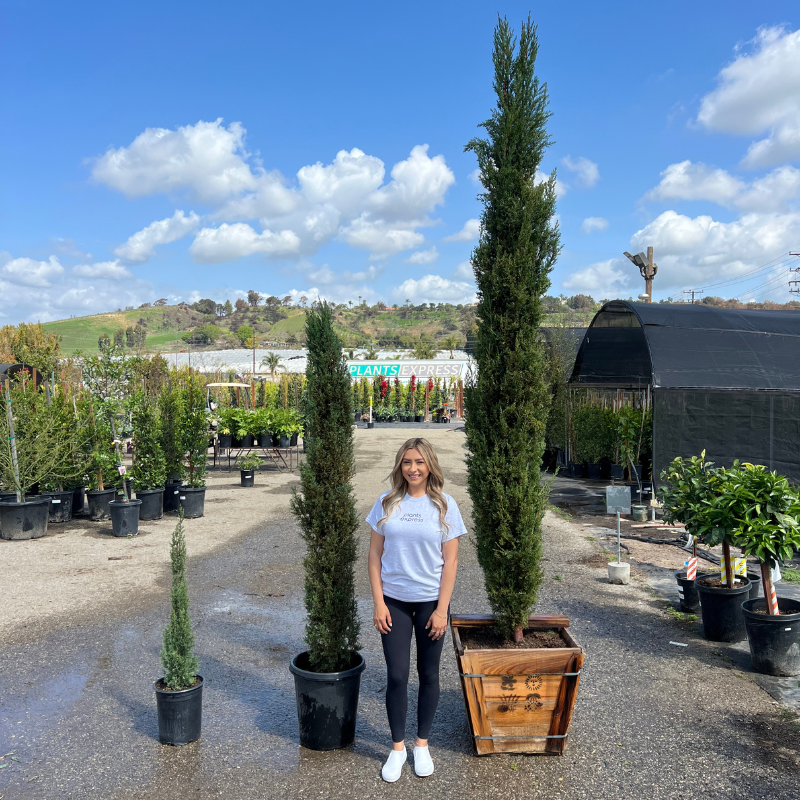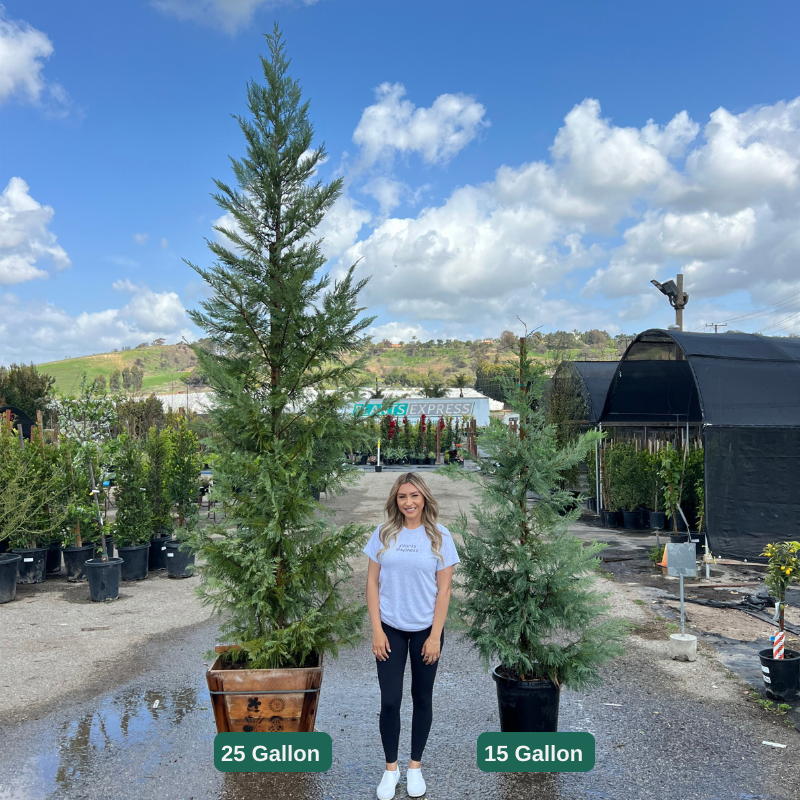Italian Cypress (Cupressus sempervirens) is an iconic, elegant tree known for its tall, narrow form and distinctive Mediterranean look. Its striking silhouette and lush evergreen foliage make it a favorite choice for adding vertical interest, creating privacy screens, or framing pathways and driveways. Italian Cypress is relatively easy to grow, making it a popular choice for landscaping in a variety of climates, especially in warmer regions.
In this comprehensive guide, we’ll explore how to grow and care for Italian Cypress trees, from planting and watering to pruning and pest management. By following these tips, you can ensure your Italian Cypress trees thrive, bringing beauty and structure to your garden for years to come.
.
Why Choose Italian Cypress?
Italian Cypress trees are perfect for adding an air of sophistication and elegance to any landscape. Here are some reasons why they are a popular choice among gardeners and landscapers:
- Narrow, Columnar Shape: Their tall, slender growth habit makes them ideal for tight spaces and adds vertical interest to the landscape.
- Evergreen Foliage: Italian Cypress trees provide year-round greenery, offering color and structure throughout the seasons.
- Low Maintenance: Once established, these trees are relatively low-maintenance, drought-tolerant, and easy to care for.
- Versatility: They can be used as privacy screens, windbreaks, garden borders, or accent plants.
- Hardiness: Italian Cypress is well-suited for warm and temperate climates, thriving in USDA zones 7-11.
Whether you want to line your driveway with stately evergreens or create a natural privacy screen, Italian Cypress trees are an excellent choice that can enhance the beauty and functionality of your outdoor space.

Italian Cypress Tree Characteristics
Italian Cypress has a distinctive appearance that makes it easy to recognize. Here’s a breakdown of the key features of these trees:
- Height: Italian Cypress trees can reach heights of 40-60 feet, and in some cases, they can grow even taller. However, they remain narrow, typically only spreading 3-5 feet in width.
- Foliage: The foliage is dense, with a rich dark green to bluish-green color. The needle-like leaves grow tightly along the branches, creating a lush, columnar look.
- Growth Rate: Italian Cypress has a moderate to fast growth rate, usually gaining about 1-2 feet in height each year.
- Lifespan: Italian Cypress trees are long-lived and can thrive for 50-150 years under the right conditions.
.
Ideal Planting Conditions for Italian Cypress
To ensure your Italian Cypress trees grow healthy and strong, it’s essential to choose the right planting location and provide them with appropriate care from the start. Here’s what you need to know about ideal growing conditions:
1. Sunlight Requirements
Italian Cypress trees thrive in full sun and require at least 6-8 hours of direct sunlight each day. Planting them in a sunny spot encourages dense, healthy growth and helps prevent the trees from becoming thin or spindly.
- Pro Tip: Avoid planting Italian Cypress in shaded or partially shaded areas, as inadequate sunlight can cause poor growth and sparse foliage.
2. Soil Preferences
Italian Cypress trees prefer well-draining soil with a slightly acidic to neutral pH (6.0-7.5). Although they can tolerate various soil types, including sandy and clay soils, poor drainage can lead to root rot, so amending the soil for better drainage is essential if you have heavy or compacted soil.
- Pro Tip: Add organic matter or coarse sand to improve soil drainage before planting in areas with heavy clay soil.
3. Climate and Hardiness Zones
Italian Cypress is well-suited for warm, Mediterranean-like climates and thrives in USDA zones 7-11. It can tolerate high temperatures and some drought once established, but it’s less suited for areas with extremely cold winters.
- Pro Tip: In cooler zones (6 or below), Italian Cypress trees may require winter protection to prevent frost damage.
 ,
,
How to Plant Italian Cypress Trees
Proper planting is crucial for ensuring the long-term health and growth of Italian Cypress trees. Follow these steps to plant them successfully:
1. Choose the Right Spot
Select a planting location that provides full sun and ample space for the tree’s height and narrow spread. Italian Cypress trees do not require much horizontal space, but they should be planted far enough away from structures, power lines, and other trees to allow for unhindered vertical growth.
2. Dig the Planting Hole
Dig a hole twice as wide and just as deep as the root ball of your Italian Cypress tree. This allows the roots to spread easily and helps the tree establish a strong foundation.
- Pro Tip: Loosen the soil around the edges of the hole to encourage root expansion and improve drainage.
3. Place the Tree in the Hole
Remove the tree from its container and gently loosen any tangled or circling roots. Place the tree in the hole, ensuring the top of the root ball is level with or slightly above the surrounding soil.
4. Backfill and Water
Backfill the hole with soil, tamping it down gently to eliminate air pockets. Water the tree thoroughly after planting to help the soil settle and encourage root growth.
5. Mulch Around the Base
Apply a 2-3 inch layer of mulch around the base of the tree, leaving a few inches of space around the trunk. Mulching helps retain moisture, regulate soil temperature, and suppress weed growth.
.
Watering Italian Cypress Trees
Proper watering is essential, especially during the first few years as the tree establishes its root system. Once mature, Italian Cypress trees are relatively drought-tolerant, but they still require periodic watering to stay healthy.
- First Year: Water deeply once a week, especially during dry spells. Ensure the soil remains moist but not waterlogged.
- Established Trees: Once established, Italian Cypress trees can tolerate periods of drought. Water them every 10-14 days during dry weather to maintain healthy foliage and prevent stress.
Pro Tip: Use a slow-drip irrigation system or a soaker hose to water Italian Cypress trees. This method allows water to penetrate deeply into the soil, encouraging deep root growth.

Pruning and Shaping Italian Cypress Trees
Pruning Italian Cypress trees is generally minimal, as they naturally maintain their narrow, columnar form. However, occasional trimming can help keep them tidy and remove any damaged or dead branches.
- Timing: The best time to prune Italian Cypress trees is in early spring or late summer when they are not actively growing.
- Technique: Use sharp pruning shears to remove any broken, dead, or diseased branches. Lightly trim the tips to shape the tree if necessary, but avoid cutting into old wood, as it may not regrow.
Pro Tip: To maintain the tree’s natural shape, avoid heavy pruning, which can lead to an unnatural appearance and may expose the tree to stress and disease.
.
Using Italian Cypress in Landscaping
Italian Cypress trees are a versatile choice for landscaping and can be used in a variety of ways to enhance your outdoor space:
- Privacy Screens: Plant Italian Cypress trees in a row to create a natural privacy screen or windbreak. Their tall, narrow shape provides excellent coverage without taking up much space.
- Driveway Lining: Line driveways or pathways with Italian Cypress trees to create a grand, formal look that adds elegance to the entrance.
- Accent Trees: Use Italian Cypress as accent trees in the garden to create a focal point or vertical contrast against other shrubs and plants.
- Garden Borders: Plant Italian Cypress in borders or hedges to add structure and delineate garden spaces.
Pro Tip: For a classic Mediterranean look, pair Italian Cypress trees with other Mediterranean plants such as rosemary, lavender, and olive trees.
Frequently Asked Questions About Italian Cypress
Q: How fast do Italian Cypress trees grow?
A: Italian Cypress trees grow at a moderate rate, usually about 1-2 feet per year under ideal conditions.
Q: Can Italian Cypress trees grow in pots?
A: Yes, Italian Cypress can be grown in large pots or containers, making them suitable for patios, decks, or entryways. Be sure to use a well-draining potting mix and choose a container with drainage holes.
Q: Do Italian Cypress trees attract pests?
A: Italian Cypress trees are relatively pest-resistant, but they can attract spider mites in dry, dusty conditions. Keeping the tree well-watered and spraying it occasionally with water can help deter mites.
Q: Are Italian Cypress trees drought-tolerant?
A: Yes, once established, Italian Cypress trees are drought-tolerant and require minimal watering. However, they should be watered regularly during the first few years to establish a deep root system.
Q: Can Italian Cypress be pruned into different shapes?
A: While Italian Cypress trees are naturally narrow and columnar, they can be lightly pruned to maintain shape. However, avoid extensive shaping as it can distort their natural form.

Conclusion: Enjoying the Timeless Beauty of Italian Cypress
Italian Cypress trees bring a sense of elegance and structure to landscapes, thanks to their tall, narrow form and rich evergreen foliage. With proper care and maintenance, these trees can thrive for decades, providing privacy, shade, and aesthetic appeal. From selecting the right planting location to understanding their watering and pruning needs, this guide equips you with the knowledge to grow and care for Italian Cypress trees successfully.
By incorporating Italian Cypress into your garden, you can create a serene, Mediterranean-inspired space that adds value and beauty to your outdoor environment for years to come. Whether lining a driveway or standing as a dramatic focal point, Italian Cypress trees are a timeless choice that will elevate the look and feel of any landscape.















